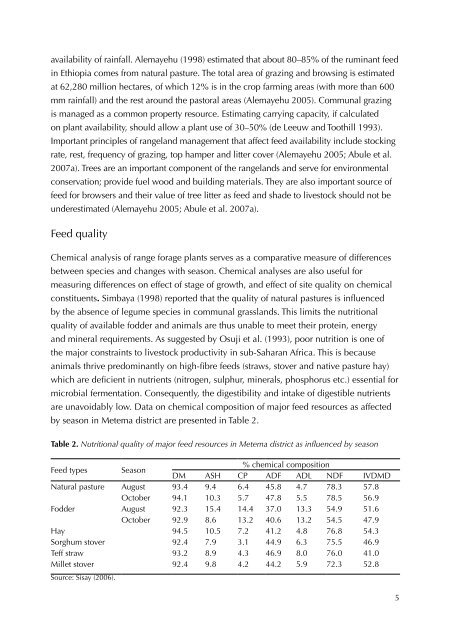Rangeland condition and feed resources in Metema District, North ...
Rangeland condition and feed resources in Metema District, North ...
Rangeland condition and feed resources in Metema District, North ...
You also want an ePaper? Increase the reach of your titles
YUMPU automatically turns print PDFs into web optimized ePapers that Google loves.
availability of ra<strong>in</strong>fall. Alemayehu (1998) estimated that about 80–85% of the rum<strong>in</strong>ant <strong>feed</strong><br />
<strong>in</strong> Ethiopia comes from natural pasture. The total area of graz<strong>in</strong>g <strong>and</strong> brows<strong>in</strong>g is estimated<br />
at 62,280 million hectares, of which 12% is <strong>in</strong> the crop farm<strong>in</strong>g areas (with more than 600<br />
mm ra<strong>in</strong>fall) <strong>and</strong> the rest around the pastoral areas (Alemayehu 2005). Communal graz<strong>in</strong>g<br />
is managed as a common property resource. Estimat<strong>in</strong>g carry<strong>in</strong>g capacity, if calculated<br />
on plant availability, should allow a plant use of 30–50% (de Leeuw <strong>and</strong> Toothill 1993).<br />
Important pr<strong>in</strong>ciples of rangel<strong>and</strong> management that affect <strong>feed</strong> availability <strong>in</strong>clude stock<strong>in</strong>g<br />
rate, rest, frequency of graz<strong>in</strong>g, top hamper <strong>and</strong> litter cover (Alemayehu 2005; Abule et al.<br />
2007a). Trees are an important component of the rangel<strong>and</strong>s <strong>and</strong> serve for environmental<br />
conservation; provide fuel wood <strong>and</strong> build<strong>in</strong>g materials. They are also important source of<br />
<strong>feed</strong> for browsers <strong>and</strong> their value of tree litter as <strong>feed</strong> <strong>and</strong> shade to livestock should not be<br />
underestimated (Alemayehu 2005; Abule et al. 2007a).<br />
Feed quality<br />
Chemical analysis of range forage plants serves as a comparative measure of differences<br />
between species <strong>and</strong> changes with season. Chemical analyses are also useful for<br />
measur<strong>in</strong>g differences on effect of stage of growth, <strong>and</strong> effect of site quality on chemical<br />
constituents. Simbaya (1998) reported that the quality of natural pastures is <strong>in</strong>fluenced<br />
by the absence of legume species <strong>in</strong> communal grassl<strong>and</strong>s. This limits the nutritional<br />
quality of available fodder <strong>and</strong> animals are thus unable to meet their prote<strong>in</strong>, energy<br />
<strong>and</strong> m<strong>in</strong>eral requirements. As suggested by Osuji et al. (1993), poor nutrition is one of<br />
the major constra<strong>in</strong>ts to livestock productivity <strong>in</strong> sub-Saharan Africa. This is because<br />
animals thrive predom<strong>in</strong>antly on high-fibre <strong>feed</strong>s (straws, stover <strong>and</strong> native pasture hay)<br />
which are deficient <strong>in</strong> nutrients (nitrogen, sulphur, m<strong>in</strong>erals, phosphorus etc.) essential for<br />
microbial fermentation. Consequently, the digestibility <strong>and</strong> <strong>in</strong>take of digestible nutrients<br />
are unavoidably low. Data on chemical composition of major <strong>feed</strong> <strong>resources</strong> as affected<br />
by season <strong>in</strong> <strong>Metema</strong> district are presented <strong>in</strong> Table 2.<br />
Table 2. Nutritional quality of major <strong>feed</strong> <strong>resources</strong> <strong>in</strong> <strong>Metema</strong> district as <strong>in</strong>fluenced by season<br />
Feed types Season<br />
% chemical composition<br />
DM ASH CP ADF ADL NDF IVDMD<br />
Natural pasture August 93.4 9.4 6.4 45.8 4.7 78.3 57.8<br />
October 94.1 10.3 5.7 47.8 5.5 78.5 56.9<br />
Fodder August 92.3 15.4 14.4 37.0 13.3 54.9 51.6<br />
October 92.9 8.6 13.2 40.6 13.2 54.5 47.9<br />
Hay 94.5 10.5 7.2 41.2 4.8 76.8 54.3<br />
Sorghum stover 92.4 7.9 3.1 44.9 6.3 75.5 46.9<br />
Teff straw 93.2 8.9 4.3 46.9 8.0 76.0 41.0<br />
Millet stover 92.4 9.8 4.2 44.2 5.9 72.3 52.8<br />
Source: Sisay (2006).<br />
5

















